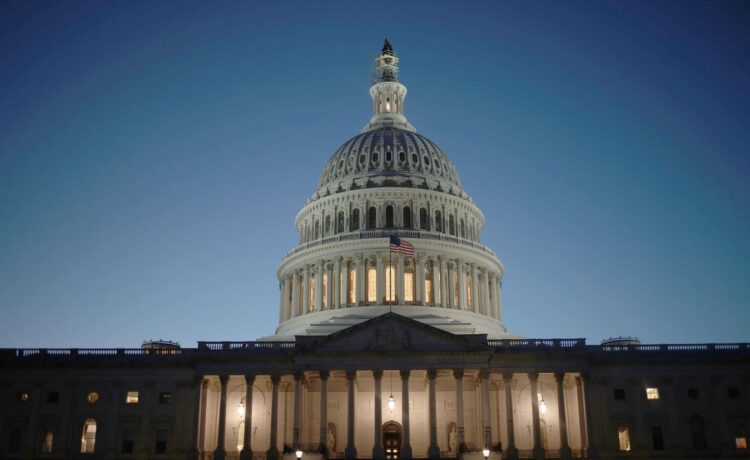WASHINGTON, DC: The U.S. Capitol Dome. (Photo by Win McNamee/Getty Images)
Lost in the barrage of news around the Trump administration’s unilateral spending cuts is that there is a legal path to impound federal spending. The Congressional Budget and Impoundment Control Act of 1974 offers a detailed roadmap for a president to terminate funds that have been provided by Congress. Choosing a different path invites legal challenges that could block the spending reforms being pursued.
Can The President Refuse to Spend Funds Provided By Congress?
While the Constitution grants the power of the purse to Congress, the president plays an essential role in budget development and execution and is empowered to ensure taxpayer dollars are spent efficiently. That includes the authority to request the termination of any funding provided through the legislative process.
President Trump has challenged the impoundment control provisions of the 1974 law as an unconstitutional encroachment on a president’s power to direct executive branch activities. His concern, however, fails to recognize his existing lawful authority to identify and propose the termination (or rescission) of any unobligated funds.
Here’s how it works. Rather than prohibiting impoundment, the law lays out procedures for impoundment. As the executive branch identifies funded items and activities for rescission, the president must send a special message to Congress explaining the rationale.
Congress must then act within 45 days. Funds proposed for rescission can be withheld from obligation during that period. While getting legislation through Congress is never an easy proposition, rescissions are granted expedited consideration — no filibuster, so passage is gained with a simple majority vote. Presidents have used the 1974 act to make such requests before, even if they’ve fallen out of favor in recent decades — echoing, perhaps, the government’s deteriorating budgeting process.
Presidential rescission requests are most neatly handled when funding is in place for the entire year. The government is currently operating under a stopgap continuing resolution, as it has every year since 1997, through March 14. But if the president were to send a formal notification of proposed spending cuts to Congress, the law would allow for a pause in spending and inform action on full-year appropriations measures.
If Congress failed to act within 45 days, the funds would then need to be spent and couldn’t be proposed for rescission again. But if congressional republicans lined up unanimously behind the president’s proposed cuts, they could achieve savings in a constitutionally consistent partnership between branches.
GAO Has An Important Statutory Role
On a related matter, the president could have notified the Congress about the pause of grants, loans, and other financial assistance ordered by the Office of Management and Budget on January 27. Notification is required in the 1974 act to explain the rationale for and timing of the spending deferrals, but none was provided. Such notice would have opened a window for the White House to prepare a rescission request for funds deemed at odds with presidential policy. Instead, the pause was announced as a legally dubious unilateral action.
In the absence of such a presidential notification, the head of the Government Accountability Office, the Comptroller General, is required by the 1974 law to report to Congress any impoundment where the President has failed to follow the procedures to rescind or defer funding. That notification would then serve the same purpose as if a special message had been transmitted by the president and the 45-day consideration period begins. The law also permits the Comptroller General to bring suit to compel the release of any funds. No such actions have occurred.
Two Different Impoundment Drivers
Part of the disagreement on this matter may flow from policymakers conflating two very different types of circumstances driving impoundment.
- Routine actions by executive branch officials at OMB and elsewhere to ensure funds are spent efficiently, reserves are set aside for contingencies, and savings are realized whenever possible. Such actions, permitted under the Antideficiency Act, are limited and not permissible for thwarting congressional priorities.
- Policy reforms to align spending with presidential policy. While a new administration often conducts a review of spending to ensure alignment with its agenda, it typically drives new spending priorities by sending a budget request to the Congress.
The president does not have the constitutional authority to substitute his judgment for that of Congress. The last president who tried in any significant way was Richard Nixon in 1972 – which led to the impoundment provisions of the 1974 act. Ever since, when courts have weighed in on the matter they have regularly held the president has no power to refuse to carry out activities funded by Congress unless they infringe on specific presidential authority granted in the Constitution, like those related to being Commander in Chief.
Supreme Court Review Of Impoundment Powers May Be Coming
In a previous post on Forbes.com, I reported how a president acting unilaterally to impound funds may end up before the Supreme Court. Given the deluge of funding cuts and freezes now being pursued by the administration, that seems increasingly likely.
While predicting how the Supreme Court might rule on the matter is anyone’s guess, decades of precedent, the plain meaning of the text in the Constitution, and the impoundment control provisions of the 1974 law all suggest it will be a difficult case for White House lawyers.
In 1998, the Supreme Court ruled in Clinton v. City of New York that the power of the president to issue a “line-item veto,” effectively the same as the power of impoundment, was tantamount to allowing the president to amend a law that Congress has written — and therefore is unconstitutional.















